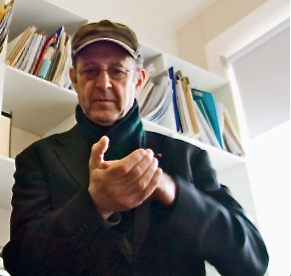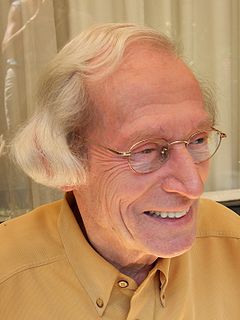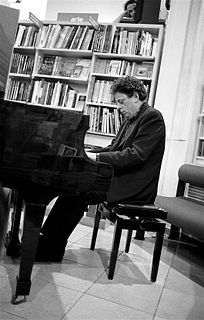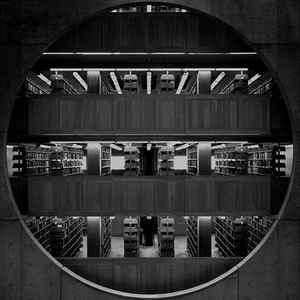Related Research Articles

An orchestra is a large instrumental ensemble typical of classical music, which combines instruments from different families, including

Philip Morris Glass is an American composer and pianist. He is widely regarded as one of the most influential composers of the late 20th century. Glass's work has been associated with minimalism, being built up from repetitive phrases and shifting layers. Glass describes himself as a composer of "music with repetitive structures", which he has helped evolve stylistically.

Stephen Michael Reich is an American composer known for his contribution to the development of minimal music in the mid to late 1960s.
La Monte Thornton Young is an American composer, musician, and artist recognized as one of the first American minimalist composers and a central figure in post-war avant-garde music. He is best known for his exploration of sustained tones, beginning with his 1958 composition Trio for Strings. His works have called into question the nature and definition of music, most prominently in the text scores of his Compositions 1960. Despite what journalist Seth Colter Walls of The Guardian calls a "legendary output that has had such an outsized influence on other artists", Young has released very little recorded material throughout his career and much of it is currently out of print.

Harry Partch was an American composer, music theorist, and creator of musical instruments. He composed using scales of unequal intervals in just intonation, and was one of the first 20th-century composers in the West to work systematically with microtonal scales. He built custom-made instruments in these tunings on which to play his compositions, and described his theory and practice in his book Genesis of a Music (1947).

Einstein on the Beach is an opera in four acts, composed by Philip Glass and directed by theatrical producer Robert Wilson, who also collaborated with Glass on the work's libretto. The opera eschews traditional narrative in favor of a formalist approach based on structured spaces laid out by Wilson in a series of storyboards. The music was written "in the spring, summer and fall of 1975." Glass recounts the collaborative process: "I put [Wilson’s notebook of sketches] on the piano and composed each section like a portrait of the drawing before me. The score was begun in the spring of 1975 and completed by the following November, and those drawings were before me all the time." The premiere took place on July 25, 1976, at the Avignon Festival in France. The opera contains writings by Christopher Knowles, Samuel M. Johnson and Lucinda Childs. It is Glass's first and longest opera score, taking approximately five hours in full performance without intermission; given the length, the audience is permitted to enter and leave as desired.
Joan Linda La Barbara is an American vocalist and composer known for her explorations of non-conventional or "extended" vocal techniques. Considered to be a vocal virtuoso in the field of contemporary music, she is credited with advancing a new vocabulary of vocal sounds including trills, whispers, cries, sighs, inhaled tones, and multiphonics.
Minimal music is a form of art music or other compositional practice that employs limited or minimal musical materials. Prominent features of minimalist music include repetitive patterns or pulses, steady drones, consonant harmony, and reiteration of musical phrases or smaller units. It may include features such as phase shifting, resulting in what is termed phase music, or process techniques that follow strict rules, usually described as process music. The approach is marked by a non-narrative, non-teleological, and non-representational approach, and calls attention to the activity of listening by focusing on the internal processes of the music.

Six Pianos is a minimalist piece for six pianos by the American composer Steve Reich. It was completed in March 1973. He also composed a variation for six marimbas, called Six Marimbas, in 1986. The world première performance of Six Pianos was in May 1973 at the John Weber Gallery in New York City. The European première took place in January the next year in Stuttgart, Germany.
Jon Gibson was an American flutist, saxophonist, composer and visual artist known as one of the founding members of the Philip Glass Ensemble. He was a key player on several seminal minimalist music compositions.

Steve Reich and Musicians, sometimes credited as the Steve Reich Ensemble, is a musical ensemble founded and led by the American composer Steve Reich. The group has premiered and performed many of Reich's works both nationally and internationally. In 1999, Reich received a Grammy Award for "Best Small Ensemble Performance " for the ensemble's performance of Music for 18 Musicians.

The Photographer is a three-part mixed media performance accompanied by music by composer Philip Glass. The libretto is based on the life and homicide trial of 19th-century English photographer Eadweard Muybridge. Commissioned by the Holland Festival, the opera was first performed in 1982 at the Royal Palace in Amsterdam.
David Russell Borden is an American composer and keyboard player of minimalist music.

Pieter William Kee was a Dutch organist and composer.

Kit Downes is a BBC Jazz Award winning, Mercury Music Award nominated, solo recording artist for ECM Records.

The Cello Concerto No. 1 was written by Philip Glass in 2001. It was one of the first concerti of the twenty-first century. The piece was commissioned by William and Rebecca Krueger, friends of both the cellist Julian Lloyd Webber and the conductor Yu Long in celebration of Lloyd Webber's 50th birthday and the first anniversary of Maestro Yu's China Philharmonic Orchestra. The work was premiered by Lloyd Webber with Long Yu conducting the China Philharmonic during the 2001 Beijing Music Festival, and attracted significant attention as the first time the work of a major western composer had its world premier in China. A typical performance takes about 30 minutes. The work is paired with the Concerto Fantasy for Two Timpanists and Orchestra as part of Glass' Concerto Project, a series of collected concerti by the composer. The cello concerto is among the most famous of Glass' works for a solo instrument.

The Piano Concerto No. 2 was written by Philip Glass in 2004. It is also called the Piano Concerto No. 2: After Lewis and Clark, due to its musical representation of the American pioneers. It was composed for the Nebraska Lewis and Clark Bicentennial Commission, the Lied Center for Performing Arts, and the University of Nebraska-Lincoln Hixson-Lied College of Fine and Performing Arts. It is included as one of the concerti in Glass' Concerto Project, a four-volume collection of commissioned works. The work itself deals with the journey of Meriwether Lewis and William Clark, interpreting the stages of their expedition progressively in each movement.

Bruce Brubaker is a musician, artist, concert pianist, and writer from the United States.
Reed Phase, also called Three Reeds, is an early work by the American minimalist composer Steve Reich. It was written originally in 1966 for soprano saxophone and two soprano saxophones recorded on magnetic tape, titled at that time Saxophone Phase, and was later published in two versions: one for any reed instrument and tape, the other for three reed instruments of exactly the same kind. It was Reich's first attempt at applying his "phasing" technique, which he had previously used in the tape pieces It's Gonna Rain (1965) and Come Out (1966), to live performance.

Exercises is the fifth extended play in the discography of Canadian musician Michael Silver, known by his stage name as CFCF. The extended play was inspired by brutalist architecture and several synthesizer-heavy modern classical and piano-only works that Silver listened to during the fall and winter of 2010–11, which were the "soundtrack" to how he felt "kind of uncertain” in those seasons. Its cover art by Ken Schwarz, Josh Clancy, and Travis Stearns shows one of the buildings the extended play was inspired by.
References
- 1 2 Strickland, Edward (1993). Minimalism: origins. Bloomington: Indiana University Press. ISBN 0-253-21388-6.
- ↑ Notes by Tim Page on philipglass.com.
- ↑ Kozinn, Allan (2004). The New York Times Essential Library: Classical Music: A Critic's Guide to the 100 Most Important Recordings. New York: Times Books. ISBN 0-8050-7070-2.
- ↑ "Music in Twelve Parts". Archived from the original on 29 January 2017. Retrieved 2 May 2017.